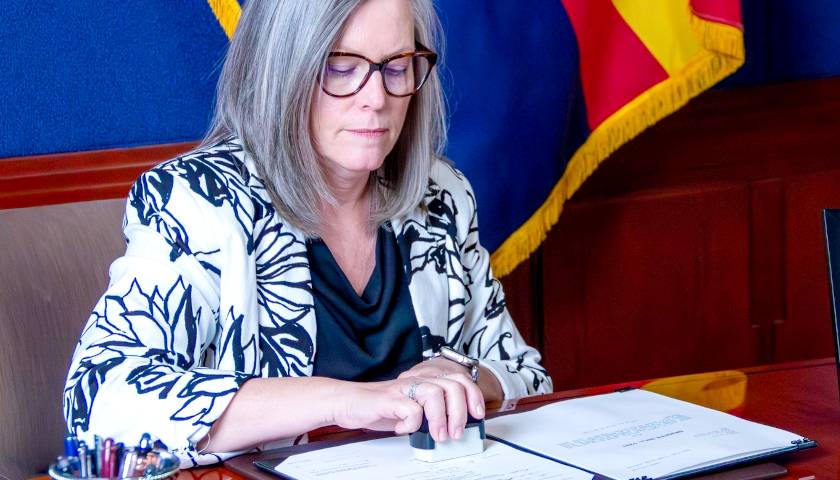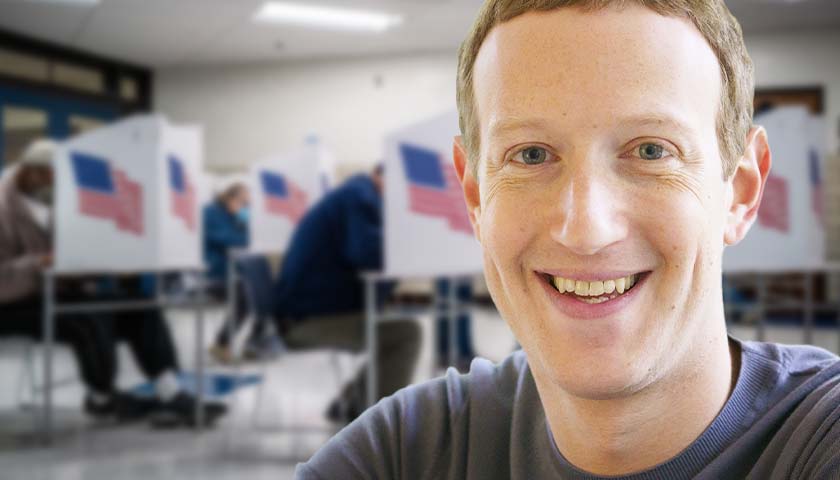by William Doyle
Now that Mark Zuckerberg-backed Center for Technology and Civic Life has released its federal tax forms detailing where its $350 million in election funding was spent, we would expect to see the usual claims of “nonpartisanship” and “money for safe elections in the midst of COVID-19” narrative being amplified by CTCL apologists. And we would not be disappointed.
“Sensitive to the criticism that big CTCL money was intended to aid Joe Biden in his 2020 presidential campaign, Zuckerberg and [Priscilla] Chan [recently] tapped prominent Republican election lawyer Michael Toner to review the grants CTCL awarded last year to counties and other jurisdictions across the country,” according to the Washington Examiner.
Toner, former chairman of the Federal Election Commission, “discovered that more Republican jurisdictions, defined as municipalities that voted for Trump in 2020, applied for and received grants from CTCL [than Democratic jurisdictions].”
In addition, Ben Labolt, a spokesman for Zuckerberg and Chan, told Yahoo News that “nearly 2,500 election jurisdictions from 49 states applied for and received funds, including urban, suburban, rural, and exurban counties . . . and more Republican than Democratic jurisdictions applied for and received the funds.”
Claims such as these have been repeated ad nauseam, but they are absurd and deliberately misleading. It is like a wealthy man claiming that all of his 10 children were treated fairly in his will because they each received an inheritance from his $70 million fortune, when—upon closer inspection—it turns out that nine of his children received $5,000 each in Google Play cards, while one favored child received $69,955,000 in cash and securities.
Consider the role that CTCL played in Wisconsin, which was “ground zero” for CTCL’s assault on the U.S. election system. The first major CTCL grants went to “the Wisconsin Five” (Green Bay, Kenosha, Madison, Milwaukee, and Racine) in the summer of 2020, well before CTCL’s “open call” for grants went nationwide in September 2020. Their grant applications were solicited, encouraged, and incentivized by CTCL officials. This was an entirely top-down endeavor, initiated by CTCL, not by cash-starved election offices desperately seeking additional funding. A very similar game played out regarding CTCL involvement nationwide.
In Wisconsin, 216 communities got CTCL grants totaling around $10.3 million. But over 200 of these small $5,000 grants, which appear to have been handed out indiscriminately, accounted for only 10 percent of the group’s statewide spending.
Many of the grants did indeed go to so-called Republican jurisdictions, but a $5,000 lump sum payment is not enough to make a major difference in the functioning of an election office, where it would barely pay for a decent office copying machine.
On the other hand, the distribution of CTCL grant amounts, as opposed to the number of grants (regardless of grant size), shows systematic partisan bias in favor of Democrats.
Furthermore, grants such as Milwaukee’s $3,409,500 ($5.75 per capita), Green Bay’s $1,600,000 ($15.30 per capita), or Racine’s $1,669,100 ($21.74 per capita) represented huge inflows of money into their election offices—more than large enough to bend the behavior of election officials toward the will of CTCL officials to generate as many additional votes for Joe Biden as possible over Hilary Clinton’s 2016 Wisconsin totals.
There is no way to twist the data to fit the “nonpartisan” narrative.
- $8.8 million, or 85 percent of CTCL grant money in Wisconsin, went to “the Wisconsin Five,” all heavily Democratic cities, with a partisan bias favoring Democrats by 37 percentage points on average.
- $9.2 million, or about 90 percent of total CTCL spending in Wisconsin, went to 15 reliably Democratic cities, which are distributed among only 11 out of 72 of Wisconsin’s counties.
- Cities in the two most heavily Democratic counties in the state received a total of $4.79 million in CTCL grants, or 46.5 percent of total CTCL spending in Wisconsin, even though they make up only 25.6 percent of the state’s population. Between Dane and Milwaukee Counties, Joe Biden beat Donald Trump by 364,372 votes in a state that Biden won by less than 21,000 votes.
As the recent flurry of pro-CTCL stories suggests, Democrats and their operatives in mainstream media will spare no effort to shield CTCL and the ZuckBuck-funded and COVID-19-battered 2020 election from serious scrutiny or criticism.
They seem to know they cannot win a national election without duplicating 2020’s unique set of circumstances. As Nsé Ufot, CEO of the Stacey Abrams-founded New Georgia Project said in July, “If there isn’t a way for us to repeat what happened in November 2020, we’re f—ed.”
What happened was this:
First, COVID-19 was used as a pretext in many states to put a moratorium on election integrity laws, guidelines, and ballot verification procedures that have been long-standing and time-tested. The result was chaos, especially in states that suddenly moved from very limited absentee voting toward near-universal absentee voting in a very short period of time, such as Wisconsin.
Second, CTCL arrived on the scene with $350 million of Mark Zuckerberg’s money, and a plan to infiltrate election offices in key areas with Democratic election activists sent along to take advantage of the chaos. This had nothing to do with traditional Democratic or Republican campaign spending. It was all about financing a takeover of local election offices by partisan activists armed with a plan to transform those election offices into sophisticated get-out-the-vote machines for Joe Biden.
To that end, those offices were then used as a platform to implement their preferred administrative practices, promote their preferred voting methods (especially absentee, mail-in voting), and implement sophisticated and expensive ballot harvesting efforts, as well as launch intensive multimedia outreach campaigns and surgically targeted, get out the vote efforts that were exclusively directed toward areas heavy with potential Democratic voters.
As a result of CTCL involvement, the outcome of the 2020 election is not the outcome that would have occurred if the election had been conducted on the basis of established election laws, equal treatment of voters, and administrative neutrality.
Again, Wisconsin provides a perfect example of how laser-targeted, conditional CTCL grants worked to swing the 2020 election in favor of Joe Biden. Wisconsin’s major grant recipients were required:
- First, to “Encourage and Increase Absentee Voting (By Mail and Early, In-Person),” mainly through providing “assistance” in absentee ballot completion and submission, and the installation of ballot drop boxes.
- Second, to “dramatically expand strategic voter education [and] outreach efforts, particularly to historically disenfranchised residents.”
- Third, to recruit new election workers, mainly from among paid young activists who would replace the usual, older, election day volunteers.
CTCL was extremely effective in advancing its goals, especially with promoting absentee voting. Prior to 2020, the rate of absentee voting in Wisconsin was 4.6 percent on average in 2016, and 5.5 percent in 2018. Wisconsin had no experience with widespread absentee voting when the average statewide absentee voting rate suddenly soared to 58.9 percent in 2020.
Absentee voting rates were far higher than the statewide average among the CTCL funded Wisconsin five counties, where 70.6 percent of all ballots were absentee ballots. Biden’s vote margins were largest in Milwaukee and Dane counties, which each had absentee voting rates above 70 percent. In addition, four out of the five counties that experienced the largest Democratic shifts in 2020 were the four counties with the highest absentee voting rates.
The overall results were devastating for Donald Trump’s chances in Wisconsin, and perhaps for Republican chances in general in Wisconsin going forward:
- Dane and Milwaukee Counties got 46.55 percent of total CTCL spending even though they make up only 25.6 percent of the state’s population. In return, they delivered Joe Biden a margin of victory over Donald Trump of 364,372 votes in a state that Biden won by less than 21,000 votes.
- 87 percent of cities that got substantial CTCL grants became more heavily Democratic. Even Republican majority cities like Wausau, Waukesha, and Brookfield (in Waukesha county) became less Republican in 2020. Waukesha County, Wisconsin’s reliably red and third most populous county, shifted Democrat by an astonishing 5.85 percent in 2020, while solidly red Marathon county also shifted Democrat. Even though they remained Republican counties, they are much less so now.
- Extremely blue Dane County became even bluer, with the Democratic Party’s vote share increasing by a stunning 5.28 percent to a 56.21 point advantage. Populous Milwaukee County saw a 3 percent increase in the Democrats’ vote share to a 36.9 point advantage, again from an already very high level.
- These partisan shifts are not caused by voters switching sides. Donald Trump increased his vote totals throughout the Wisconsin five counties compared to 2016 by more than 12 percentage points, with the exception of Dane County.
All told, we estimate that CTCL spending in Wisconsin generated an additional 65,222 votes for Joe Biden, without which Donald Trump would have defeated Biden in Wisconsin by 44,540 votes.
This estimate is closely aligned with our undisputed Texas results, where we were able to employ a more sophisticated methodology because of the wider distribution of large CTCL grants. We estimated that the additional Biden votes that could be attributed to CTCL in Texas were about 200,000, or 3.8 percent of his statewide total. In this case, where CTCL experienced far more favorable circumstances for their operations than in Texas, our estimate is 4 percent of Biden’s Wisconsin statewide total.
Unless the residual partisan impact of CTCL funding is reversed, one of the most significant effects of CTCL’s intervention in Wisconsin will have been to make its most populous counties significantly more Democratic than they were in 2016. These changes could have a decisive impact on elections in 2022 and 2024, especially if an organization like CTCL attempts to replicate its 2020 effort in the future.
A bill to prevent private funding of Wisconsin’s elections in the future recently passed both houses of the Wisconsin legislature but was vetoed by Wisconsin Governor Tony Evers, a Democrat. It’s doubtful he will reconsider his veto after reviewing this evidence.
– – –
William Doyle, Ph.D., is the principal researcher at the Caesar Rodney Election Research Institute in Delaware.
Photo “Mark Zuckerburg” by Anthony Quintano CC BY 2.0 and photo “voting booths” by Tim Evanson CC BY-SA 2.0.





